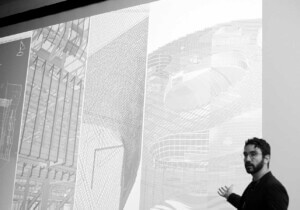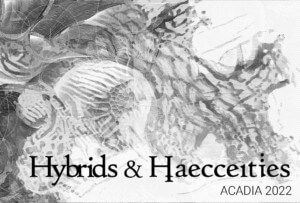New modeling software enables experimental volumetric design
In a revolt against the realm of the 3D renderings they feel contemporary architects are confined to working within, Matter Design‘s principals Brandon Clifford and Wes McGee founded a studio grounded in digital design that addresses the realities of materials, loads and physicality. Clifford in particular mourns the loss of our “ability to work with volume,” so much so that he spent his year as the 2011-12 LeFevre Emerging Practitioner Fellow at Ohio State University Knowlton School of Architecture researching volume in building with a special focus on stereotomy, the art of precisely carving solids. It was this research that led him to design La Voûte de LeFevre, a vaulted wooden structure that soars thanks to weight and mass, not in spite of it.
La Voûte (French for vault) is a compression-only structure, meaning there is zero tension. Think of it like the inverted spires found in Gothic cathedrals. “Those spires are not decorative,” said Clifford and McGee in an email. “They are, in fact, redirecting this thrust network down into the column. If you took the spire off the cathedral the structure would collapse” (Watch two short videos Matter Design made to illustrate this point). To design a reverse spire with a perfectly balanced weight ratio, Clifford found that the computer modeling software he needed didn’t exist, so he wrote his own. Called Thick Funicular, the program runs a particle-spring library across a desired geometry. “Each particle in the system calculates the distance from the desired geometry and then reassigns that value to its weight,” said Clifford. “It can open and close apertures to make a unit weight more or less relative to its neighbors. Once the calculation has guaranteed that a solution holds a thrust network inside its thickness, the process is complete and the units are carved with their uniquely dimensioned holes. I think the key here is to think of these holes as controlling the volume (or weight) of each unit relative to its thickness and location in the figuration of the vault.”
Even though stone is traditionally used in stereotomic projects, Clifford and McGee had, among other constraints, a budget to consider, and so chose to work with Baltic birch plywood, which “is homogeneously dense and has significant self-mass.” Unfortunately, it only comes in ¾ inch sheets, hardly thick enough for La Voûte’s 2 to 12 inch-thick structure. Clifford and McGee knew they would need to glue the wood together in layers, but to reduce waste they “segmented the units, cut them from the ¾ inch sheet material and stacked them together into the rough geometry of the final unit (plus ⅛ inch for safe measure). Those sheets were then placed on the five-axis mill and carved to the precise geometries.” If you can’t wrap your head around that, watch the video of the milling process. You’ll see the five-axis Onsrud router, an incredible machine fitted with a large bit that cuts with the tip as well as with the sides, removing the most material with the minimum effort.
After it was fabricated in University of Michigan’s FABLab, where McGee is the director, it was transported to the Banvard Gallery at Ohio State University Knowlton School of Architecture. Clifford and McGee installed La Voûte from the top down using a compression ring around the perimeter of the room as a tool against which they could measure each row as they worked their way down. Like the spires of Gothic cathedrals, La Voûte was built with a vertical thrust designed to last a lifetime, but because the installation is temporary the individual units are held together with screws and wooden dowels to allow for their removal. Still, La Voûte – or rather the ability to design and fabricate a structure like it – lives on in Clifford’s remarkable new Thick Funicular program.










